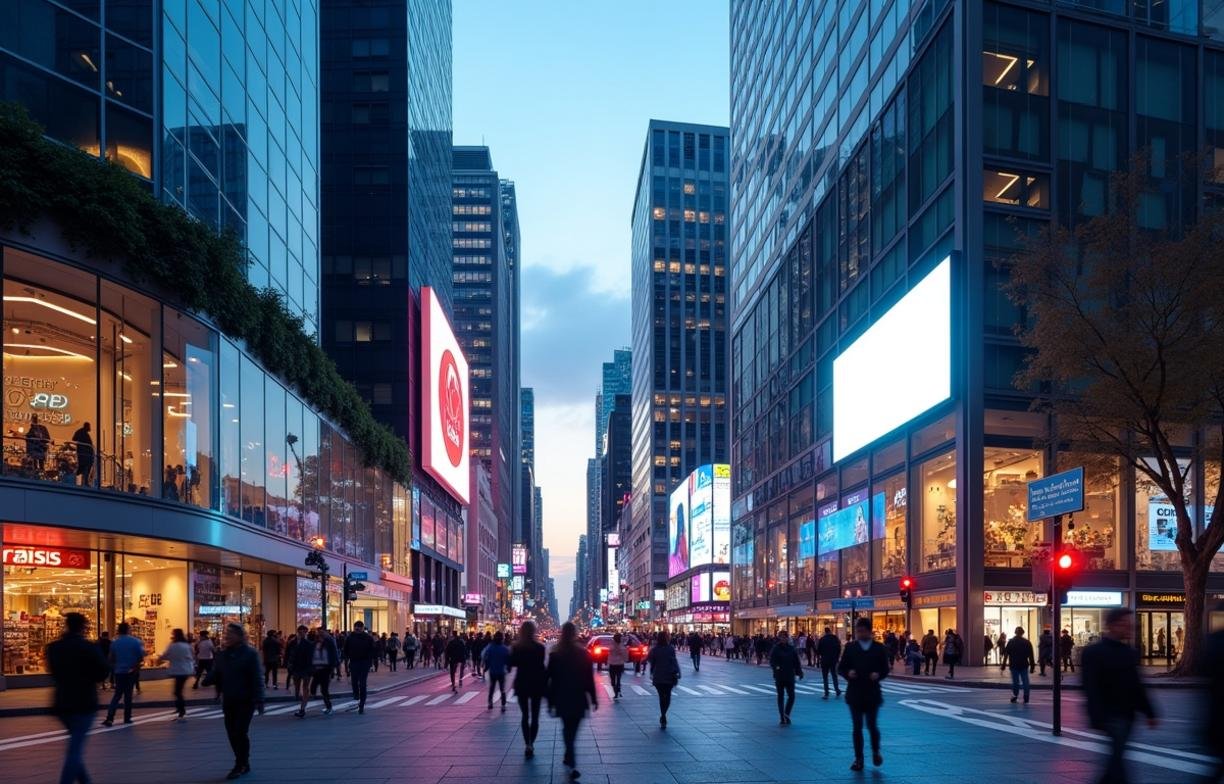Cities worldwide are integrating advanced technology, transforming the future of outdoor advertising. More urban landscapes are incorporating sensors, connected devices, and interactive displays that turn everyday streets into dynamic platforms. This trend is compelling brands and marketers to explore innovative strategies that capture attention in unique, meaningful ways. As city planners focus on efficiency, sustainability, and enhanced public experiences, large-scale campaigns are beginning to transform into personalized, responsive interactions.
Forward-thinking organizations are beginning to utilize smart networks and sophisticated data to fine-tune messages in real time. Instead of static billboards that remain the same for months, these intelligent displays now adapt to passing audiences, weather conditions, and even local events. They’re designed to blend into the surroundings while also standing out to the right people at the right moment. Through insightful analytics, advertisers can measure campaign performance and make swift changes that yield better results.
Contents
- 1 A New Era of Interactivity
- 2 Key Trends Shaping Digital Signage
- 3 Integrating IoT in Modern Billboard Technology
- 4 Data-Driven Approaches for Consumer Engagement
- 5 Expanding Boundaries with Augmented Reality
- 6 Sustainable Development and Green Advertising
- 7 Looking Ahead to Smarter Advertising Landscapes
A New Era of Interactivity
Advertising that responds to human inputs has been gaining traction in recent years. Many digital signboards now feature motion sensors and facial detection capabilities that adjust content for each viewer. People passing by might see a video or animation tailored to their age group or demographic profile.
Technology Shaping Brand Engagement
Sensors can track engagement metrics, such as dwell time and foot traffic patterns. This level of detail helps brands tailor campaigns for neighborhoods with specific interests or buying habits. Creative agencies have started experimenting with immersive visuals, making city streets come alive with AR elements that entertain, inform, and delight.
On top of these interactive experiences, passersby may be invited to engage further through QR codes or short links. That can direct them to special offers or product details. By combining digital innovation with physical displays, local communities begin to see advertising that actually contributes to their environment rather than cluttering it.
Key Trends Shaping Digital Signage
As screens become slimmer, displays with ultra-high definition and vivid color have become more affordable. Cities around the globe are upgrading old-fashioned billboards and traditional posters with modern digital signage that is visually striking and efficient to maintain.
Advanced screens can handle dynamic content, allowing advertisers to rotate multiple messages. Digital displays make it simpler to run time-sensitive campaigns, such as event promotions or seasonal sales. Also, more energy-efficient LED technology helps reduce power consumption, aligning with eco-friendly urban development goals.
Personalization Through Real-Time Data
Data is at the heart of personalized ads. With real-time analytics, marketers can adjust campaigns to align with local traffic trends or high-traffic moments. If an evening commute typically sees an influx of professionals, ads might switch from family-friendly promotions to career-focused messaging.
By integrating this level of personalization, advertisers aim to engage on a more human level. City dwellers will always see relevant information instead of repetitive, generic videos. That targeted approach often yields heightened recall rates and better overall brand sentiment.
Integrating IoT in Modern Billboard Technology
Smart cities rely on Internet of Things (IoT) devices to bring intelligence to essential services like transportation, waste management, and energy grids. Outdoor advertising also stands to benefit from these IoT networks. Intelligent billboards can collect city data and react instantly.
When pollution levels spike, displays might switch to eco-friendly brand messages that raise environmental awareness or promote solutions. If traffic flows are diverted, signage can provide alternative routes or highlight neighborhood shops to keep business steady. This seamless exchange of information between billboards and city systems turns once-static ads into vital communication tools.
Layered Connectivity for Seamless Experiences
Many of these IoT-driven ads use Wi-Fi or Bluetooth to connect with people’s mobile devices. Passersby might receive personalized coupons or notifications based on their whereabouts. This connectivity builds an ongoing conversation between the brand and its audience.
By using beacons and geofencing, retailers can track patterns in shopping districts. They might learn that the busiest time is Friday afternoon. In response, ad placements can shift to highlight special weekend offers, drawing early crowds into stores and enhancing local commerce.
Data-Driven Approaches for Consumer Engagement
Accuracy in gathering analytics is transforming how advertisers plan campaigns. Rather than guesswork, decisions are guided by robust data showing who is paying attention, how long they linger, and what prompts them to take action. Modern technology now monitors everything from total impressions to conversion metrics that occur when an individual sees an ad and later visits a website.
This data-driven philosophy also extends to digital payments and e-commerce. Recognizing that people spend a significant portion of their time on mobile devices, advertisers tailor calls to action that sync with transactional platforms. A simple text prompt on a billboard can link to an online shopping cart. That direct path shortens the customer journey, which boosts engagement and sales.
Measuring Return on Investment
Brands, agencies, and local governments all need a documented return on their advertising investments. With advanced tracking systems, it’s becoming clear how outdoor ads influence sales, online sign-ups, or event attendance. If a particular spot underperforms, campaigns can immediately shift to locations with stronger numbers.
This strategy not only curbs overspending but also heightens the relevance of ads people see. When messages are well-targeted, audiences are more receptive. That approach ensures budgets are allocated wisely for the benefit of both advertisers and local communities.
Expanding Boundaries with Augmented Reality
Augmented reality (AR) is a game-changer for creative outdoor campaigns. It overlays digital elements on top of the physical environment, blending the virtual and real worlds. With AR-equipped devices, city dwellers can see ordinary surfaces transform into dazzling brand experiences that capture their imagination.
When a person scans a building facade with a mobile app, an animated figure might appear, interacting with the space. That level of novelty fosters memorable encounters and can spark viral shares on social media. AR-driven methods represent the next frontier, where a simple city walk can feel like stepping into an interactive story.
Collaborative Efforts for Futuristic Campaigns
Large-scale AR projects often demand partnerships between tech startups, creative agencies, and city officials. Every stakeholder ensures that installations are executed properly and align with local regulations. There’s also a focus on public safety, especially when immersive content might cause people to pause or stop in busy areas.
Nevertheless, the payoff is enormous. Brands that successfully deploy AR often achieve substantial buzz, with potential customers eagerly seeking out these futuristic displays. By merging reality with digital wizardry, new campaigns bring wonder back to advertising.
Sustainable Development and Green Advertising
As environmentally conscious living dominates public conversation, many cities focus on responsible energy usage and eco-friendly materials. Outdoor advertising is no exception. Solar-powered digital billboards, recycled construction materials, and energy-saving LEDs demonstrate a commitment to greener practices.
These sustainable approaches reduce a brand’s carbon footprint. They also help meet the expectations of modern consumers who value responsible business operations. Forward-looking companies see an advantage in associating their messages with green technology, reinforcing brand trust among the eco-minded population.
Designing for Longevity
Green campaigns are more than just a temporary trend. Ad structures and displays designed with long-term impacts in mind can withstand weather elements and energy constraints. Engineers might install solar panels or rely on efficient power management systems.
This attention to longevity appeals to local governments eager to maintain clean, attractive environments. When creative teams take sustainability into account, they not only comply with regulations but also earn support from residents who appreciate conscious urban progress.
Looking Ahead to Smarter Advertising Landscapes
Many technology experts predict that tomorrow’s urban corridors will feature holographic ads, drone displays, and deeply personalized messages driven by AI analysis. Some developers are even experimenting with next-generation sensors that gauge emotional responses from crowds. While that raises questions about privacy and data security, it also opens new worlds for creativity and brand awareness.
Such bold innovations point to a future where advertising may blur the line between brand outreach and public service. Imagine networks of screens that adapt to a city’s mood or real-world events, offering both commerce and valuable updates. The evolution of connectivity and data-driven insights lays the groundwork for an era of truly immersive brand experiences. It’s an exciting transformation that will continue to reshape the streets of tomorrow.



